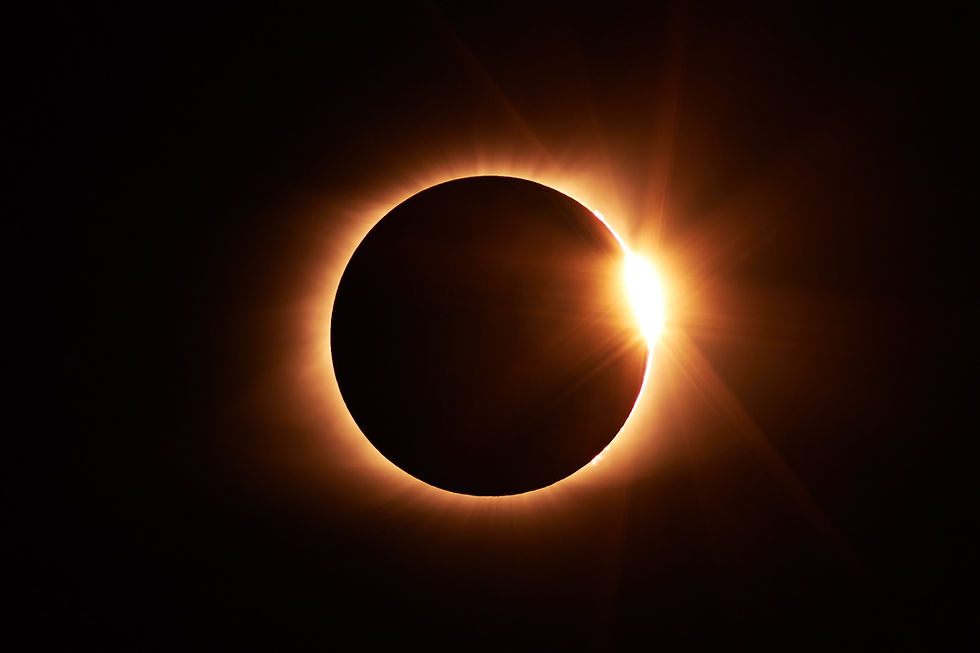
All About Eclipses
Learn about solar and lunar eclipses!
Eclipses occur when the Earth and Moon cast shadows on one another. Although the Moon orbits the Earth every 27 days, its orbit is tilted by about 5 degrees. Because of this, the shadows of the Earth and Moon usually miss each other entirely. Eclipses are only possible on occasion when the Sun, Moon, and Earth come into close alignment.
Lunar eclipses occur when the Earth casts its shadow on the Moon. This can only happen when the Moon is full. Because the Earth is larger than the Moon, its shadow can completely cover the Moon’s disk. As the Moon passes into the Earth’s shadow, it becomes dark and turns deep shades of red and orange due to sunlight being refracted through Earth’s atmosphere. Because of this color, total lunar eclipses are sometimes referred to as a “Blood Moon”. During totality, the surrounding stars appear brighter as the moon darkens for several hours.
There are three types of lunar eclipses:
Total Lunar Eclipse: The darkest part of Earth’s shadow (umbra) completely covers the Moon.
Partial Lunar Eclipse: The umbra covers a portion of the Moon’s disk.
Penumbral Lunar Eclipse: The soft edge of the Earth’s shadow (penumbra) covers a portion of the Moon’s disk. This results in a slight dimming that is barely noticeable.
Everyone on the nighttime side of the Earth can see a lunar eclipse, making them quite common and easy to view. Lunar eclipses can safely be viewed through binoculars and telescopes without protective filters.

Solar eclipses occur when the Moon casts its shadow on the Earth, blocking out all or a portion of the Sun in the sky. This can only happen when the Moon is new. Because the Moon is smaller than the Earth, solar eclipses are less common than lunar eclipses from any given location. There are three types of solar eclipses.
Partial Solar Eclipse: The Moon covers a portion of the Sun’s disk in the sky. This must be viewed through protective filters. Partial eclipses are the most common.
Annular Solar Eclipse: When viewed from specific locations on Earth, the Moon passes through the center of the Sun’s disk. The moon is too far from Earth to completely cover the Sun’s disk and a ring of sunlight surrounds the dark moon. This is known as a “ring of fire”. Protective filters must be used to view an annular eclipse.
Total Solar Eclipse: From specific locations on Earth, the Moon completely covers the Sun’s disk for up to 7 minutes. The duration of totality depends on the distance of the Moon and the location of the observer. During totality, the sky darkens to a deep twilight color and the brightest stars and planets become visible. The sun’s corona (outer atmosphere) becomes visible surrounding the dark disk of the Moon. Flame-like eruptions of pink plasma called prominences are visible around the Moon’s edge. Before totality and after the Sun’s light returns, protective filters must be used. During totality, the eclipse is safe to view directly, without filters.

Protective filters are required to view a partial solar eclipse, an annular solar eclipse, and the partial phases at the beginning and end of a total solar eclipse. These can be purchased in the form of carboard or plastic solar glasses and solar filters for telescopes, binoculars, and camera lenses. Solar filters must completely cover the front of binoculars, telescopes, or camera lenses. Protective film material is also available to make custom solar filters. Pinhole eclipse viewers can also be made to project small images of the crescent sun. Another option is eyepiece projection from an unfiltered telescope. While it works, this method can generate intense heat that could damage your telescope.
After the two Great American Eclipses of 2017 and 2024, the next total solar eclipse won’t cross the United States until 2045. For upcoming lunar eclipses and partial solar eclipses visible from Connecticut, click here.
To see where total solar eclipses will be visible in the next decade, click here.